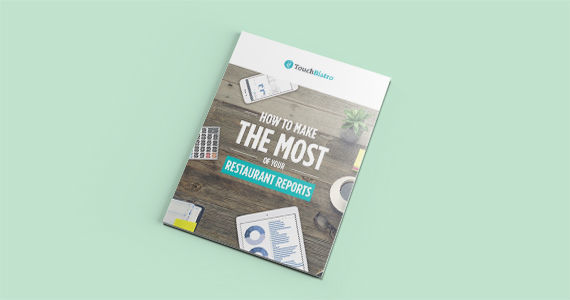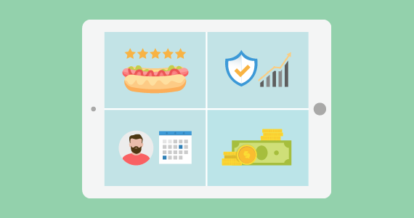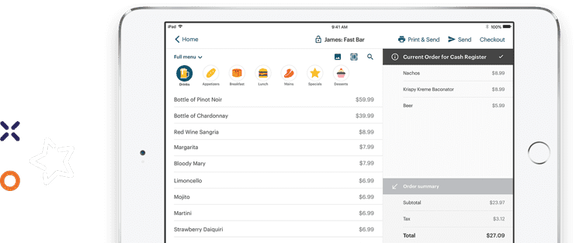Your point of sale (POS) system is packed with data and that raw data is transformed into powerful cloud POS reports that can inform everyday business decisions. Those insights can help you make better, more informed business decisions about things like marketing promotions, menu item pricing, staffing, and much more.
Want to make the most of those valuable cloud point of sale reports? Keep reading to find out:
- What a POS report is
- How POS reporting works
- The top 5 POS reports your restaurant needs
What is a POS Report?
A POS report is a collection of business data gathered by your restaurant POS software, which has been organized in a way that tells a story about your restaurant, bar, food truck, or catering company. Through these business reports, you can find out things like which menu items are selling the best, your profit margins on popular dishes, and even if your staff members are giving away free items.

Drive your business with sales reports, food costs, customer satisfaction survey, and more.
How Does POS Reporting Work?
Your POS is the central hub of information for your restaurant. It keeps track of transactions, inventory, menu prices, and much more. The best restaurant POS systems collect and store this data and make it available in the cloud in the form of easy-to-digest reports that can be accessed from anywhere at any time.
If you’re using a legacy POS system, you can access reports through your POS terminals. Unfortunately, this means you can only review reports while you’re at your restaurant, which is inconvenient considering you probably think about your business even when you’re not on site. With a cloud-based POS like TouchBistro, you can access reports from anywhere via any web-enabled device.
If you’re a TouchBistro customer, you can log into the Cloud to access your reports.

The Top 5 POS Reports Your Restaurant Needs
While there are dozens of different POS reports for restaurants, these are a few key reports you should be checking on a regular basis. We’re also sharing examples of how to use the data from each type of POS report to inform business decisions.
1. Sales Reports
POS reports that tell you about your restaurant’s transactions can help you optimize staffing and marketing choices, and more.
Sales Metrics to Track
These are the sales metrics you should be keeping track of through your POS analytics:
- Sales totals: A detailed look at purchases and returns.
- Daily sales: Purchases and returns listed by day.
- Sales by section, table, and category: Sales grouped by where they came from on the floor or menu.
- Takeout sales: Takeout, delivery, and bar tabs combined to give you a complete look at how much revenue you generated in off-site orders.
- Discounts and voids: Details about the amount of discounts and voids during service, the team members responsible for them, the manager who approved them, and the reasons for them.
- Waiter sales item totals: A list of menu items sold by each server and the revenue they generated.
How These POS Reports Help You Make Business Decisions
Here are a few ways you can use the insights from sales reports:
- Discover your most profitable table and section to inform seating and staffing assignments.
- Understand how much of your business comes from takeout versus in-venue orders, and use that data to better promote those revenue streams, such as by getting direct online ordering software or your own fleet of delivery drivers.
- Make key staffing decisions based on which servers are making the most mistakes or giving away too many discounts.
- See which staff members bring in the most sales to schedule them for more shifts and give them raises to retain them.
2. Payments Reports
Cash or card? These POS analytics give you a closer look at your customers’ preferred payment methods.
Payments Metrics to Track
Check these performance indicators on a regular basis:
- Payments and refunds: A list of cash and card payment totals and refunds.
- Payments by section: Sales details by payment type and by section.
- Credit card payments and refunds: Individual credit card payments and refunds, dates and times cards were used, order numbers, authorization numbers, amounts paid, and card tip amounts.
How These POS Reports Help You Make Business Decisions
Here’s how you can leverage those point of sales reports to optimize business outcomes:
- Understand customers’ preferred payment methods to upgrade your tech (by offering mobile payments like Apple Pay, for example) or find a card processor that gives you the best deal on processing fees.
- See patterns in refund causes (e.g., chargebacks or accidental double entry) and make changes to avoid them.
- Find out customers’ payment patterns to set card minimums.
- Analyze card usage to decide how many credit card readers you need to meet demand.

Drive your business with sales reports, food costs, customer satisfaction survey, and more.
3. Employee Reports
Coming in at about 30% of total spend, labor is one of the most expensive operational costs for restaurants. POS reports can help you keep your payroll costs in check and inform staffing decisions, both of which are critical during a labor shortage.
Employee Metrics to Track
Keep a close eye on these POS reporting benchmarks to maintain control over staffing:
- Employee shifts and hours: See how long team members worked, how many shifts they worked, when they clocked in and out, and how much pay and tips they accrued for working those hours.
- Tips: A detailed look at cash tips reported by staff members, credit card tips, and how much of those card tips have been paid out to staff.
- Deleted items: Which staff members deleted items, the number of times they deleted items from the order screen, the total number of deleted items, and the value of those items.
- No sales: A report that shows how often the cash drawer is opened using the “no sale” button.
How These POS Reports Help You Make Business Decisions
Use employee POS reports to:
- Understand how much you owe front-of-house staff in tips, and how much you need to pay tipped staff to make up the difference between tipped minimum wage and untipped minimum wage.
- Calculate your tip pool, if your restaurant has a tip pooling arrangement.
- Identify staff members who are stealing from you through deleted items and no sales reports.

4. Inventory Reports
According to our State of Full Service Restaurants Report, 40% of restaurateurs struggle to manage their inventory. POS reports can help you order the right amount of inventory every time.
Inventory Metrics to Track
Here’s what you should be paying attention to when it comes to your supplies:
- Inventory list: How many of each inventory item you have in stock.
- Menu item list: A list of your menu items, their menu prices, and what they cost to make.
- Low inventory totals: A report highlighting menu item inventory counts and their corresponding “low inventory” warning setting. For example, if you configure your POS to warn you that meat is in low stock when you have fewer than 20 servings left, then steaks will appear in this report when you have 19 servings or fewer in stock.
- Cost of goods sold: How much items cost your restaurant versus how much they sell for.
- Modifier sales: Which modifiers (e.g., avocado, extra bacon, etc.) customers request and how often, plus how much revenue they generate.
- Sales item totals: A report of all menu items, how many times each item has been ordered, the total gross revenue of each item, and the number of returns and voids per item.
- Sales by menu: A detailed look at sales listed by menu categories (i.e., appetizers, drinks, entrees, etc.) and menu (i.e., lunch, happy hour, dinner, etc.).
How These POS Reports Help You Make Business Decisions
Inventory reports can unlock powerful insights about your restaurant, including:
- Knowing when it’s time to order new supplies, so that you never have to tell customers you’re out of their favorite dish. Your inventory list can also help you reduce over- and under-ordering supplies.
- Identifying best sellers and dishes that need a sales boost. POS reports can inform marketing decisions like promotions and menu engineering.
- Understanding your profit margins on items to inform menu pricing. If the cost of goods sold is too high, you may need to increase prices or source ingredients more cheaply.
- Knowing which modifiers to add or take away from your menu to generate more sales and upsells.
5. Customer Reports
You wouldn’t be in business without loyal customers. The more you know about them, the better you can serve them.
Customer Metrics to Track
Keep track of this data to better understand your customers:
- Guest order history: Data about what your customers ordered on each visit and takeout order, including time of visit, staff member who served them, items ordered, cost of items, and gratuity.
- Reservations history: A record of when guests have dined with you, where they sat, who served them, and how much they’ve spent.
- Loyalty program engagement: Details about your loyalty program members including how many points they’ve collected, what kind of rewards they’ve redeemed, and how much they’ve spent.
You may need to add reservations, loyalty, and online ordering capabilities to your POS to access these reports.
How These POS Reports Help You Make Business Decisions
Use these powerful insights about your customers to:
- Send them personalized marketing offers they won’t be able to resist. For example, you can offer a freebie to a customer who hasn’t visited you in a while, or send customers who typically dine at your restaurant an offer for their first online order.
- Improve the customer experience. Know where to seat your regulars, or which free dessert to surprise loyal takeout customers with.
POS reports are a treasure trove of data about your business. Review each POS report regularly and use them to inform decisions about everything from staffing and menu prices to inventory orders and marketing.

Drive your business with sales reports, food costs, customer satisfaction survey, and more.






